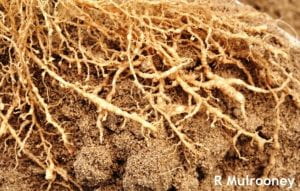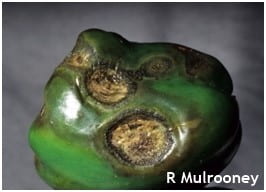Bob Mulrooney, Extension Plant Pathologist; bobmul@udel.edu
Late Blight
There have been no new late blight detections in DE or VA on potatoes. The disease apparently is under control and the weather has not been very favorable, especially where the temperatures have been over 90°F. Besides the two finds in DE and VA the only active late blight at present appears to be on Long Island, NY on both potato and tomato.
Downy Mildew on Cucurbits
As most of you know by now downy mildew was found in Sussex County on Tuesday and Dorchester County, MD. Both finds were on pickling cucumber. Since then downy mildew was found in an additional field near Bridgeton, NJ, Talbot County, MD, Wyoming County, PA, and several more cucumber fields in NC. Now is the time to be spraying specific fungicides for downy mildew on cucumbers. Continue to check the IPM pipe website for more information on the spread of downy mildew: http://cdm.ipmpipe.org.
Root Knot Nematode
Root knot nematode can be a very yield limiting pathogen on very susceptible crops like cucumbers and other vine crops, lima beans, snap beans and tomatoes to name a few. They are often worse in very sandy soils or sandy knolls in fields. With the temperatures that we have seen here in DE you can begin to see the swellings or galls on the roots in about 21 days from seeding or transplanting. Plants in infested areas of the field will be stunted and if the plants are dug carefully, if root knot is present, you will see galls of varying sizes on the roots. We have no chemical controls except for vine crops once the nematodes are seen. Vydate should be applied preventatively in fields with known root knot infestations at seeding and/or later when plants are still small. See label for details. Treating early is always better than waiting until galls can be seen.
Root knot galls on baby lima bean roots, 23 days from planting
Pepper Anthracnose
Be on the lookout for anthracnose on peppers. It has been reported in southern NJ. Anthracnose fruit rot can be a very difficult disease to control if it gets established in a field. Fields should be scouted frequently especially if peppers or tomatoes have been planted in the past. It is best controlled by preventative fungicide sprays beginning at flowering. Apply Bravo or another chlorothalonil product every 7 days and alternate with a stroblilurin fungicide (FRAC code 11) like Cabrio or Quadris plus Bravo. If anthracnose fruit rot appears, removing infected fruit from heavily infected areas will help to reduce spore loads and reduce spread if done early and often enough. Fruit will need to be removed from the field and not just thrown on the ground.
Anthracnose on pepper fruit


